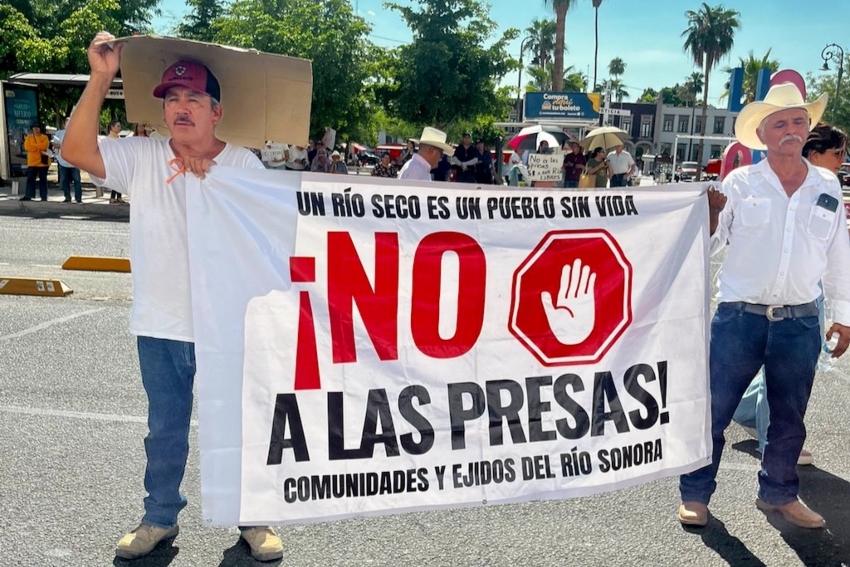By Tracy L. Barnett
Copyright mexiconewsdaily

At 8 a.m. on a sweltering Saturday morning, a convoy of pickups and cars rumbled out of the mountain town of Bacoachi, banners fluttering in the desert wind. Families leaned out of windows waving signs that read “No to dams!” as the “Megacaravan” began its 262-kilometer trek through the whole mountainous region. Along the way, more vehicles joined until nearly 70 cars — and some 600 people — pulled into Hermosillo’s university district. There, city residents were already waiting at the steps of the University Museum and Library, under an unforgiving 45 degree Celsius sun.
For organizers like Isabel Dorado Auz, a university professor and activist with Ciudadanía Activa Sonora, the Aug. 30 caravan was more than a protest. It was a living act of resistance and education.
Why Sonoran residents are protesting new dam projects
That resistance was felt again just a week later, when President Claudia Sheinbaum visited Hermosillo on Sept. 6. Río Sonora residents rallied outside her event, echoing the caravan’s call for a halt to the state government’s plan to build three new dams in the watershed — Sinoquipe, Puerta del Sol, and Las Chivas — as part of its Plan Hídrico Sonora. Officials argue the projects are needed to secure water for Hermosillo, a desert capital of nearly one million that loses more than half of its supply to leaks.
Faced with the demonstrators, Governor Alfonso Durazo said the administration was in dialogue with ejidos opposed to the dams. Their discontent, he argued, stems from a lack of information, and he pledged that “everything we do will be done in agreement with the community.”
Community leaders bristle at the suggestion that they don’t understand the project — though they welcomed Durazo’s commitment not to move forward without community consent. “If we don’t convince you, there will be no dams,” the governor told Río Sonora residents, according to a post on Ciudadanía Activa Sonora’s Facebook page. The group highlighted the statement in bold letters, superimposed on the image of a free-flowing river.
For communities along the Sonora and San Miguel rivers, the dams represent an existential threat. Many see them as a continuation of decades of water mismanagement that began long before the 2014 toxic spill that dumped 40,000 cubic meters of mining waste into the river. That disaster, still unresolved, was invoked repeatedly during the caravan as a cautionary tale of what happens when corporate and government interests override community voices.
Echoes of El Molinito
Farmers here know what dams can do to a living river. Engineer Ismael Limón, ejidatario and former irrigation district leader in Molino de Camou, remembers the day in 1991 when the Rodolfo Félix Valdés dam — better known as El Molinito — was inaugurated just upstream from his village.
“As a result of the construction of El Molinito Dam came the decline of agriculture,” Limón said. A study by hydrologist Rolando Díaz Caravantes later documented the damage. Between 1994 and 2012, irrigated farmland downstream shrank from 9,000 to 3,000 hectares. Downstream of El Molinito, part of the river corridor turned to desert, as riparian vegetation gave way to scrub. “There are communities that don’t have even a single drop of water in their wells.”
Limón, who farmed four to five hectares like most of his neighbors, saw his livelihood collapse. “Agriculture and livestock are practically paralyzed because we are small producers. Families depend on what they grow and on their animals. But right now, there is practically no irrigation water for crops.”
Industrial mining vs. agricultural needs
Meanwhile, industrial mining — particularly Grupo México’s Buenavista del Cobre in Cananea — never slowed production. “Mining has concessions for more than 50 million cubic meters of water at the source of the Río Sonora,” Limón noted. “That volume is enough to fill El Molinito dam in two years.”
Rodolfo Castro Valdez, Conagua’s general director for the northwest watershed, responded that in drought years, Conagua has prioritized urban supply over agriculture, as the National Water Law requires. He added that downstream of El Molinito, nearly 4 million cubic meters remain concessioned for 660 hectares of farmland.
Activists, however, argue that such percentages obscure the reality on the ground: that surface flows in the Río Sonora are minimal, leaving little for communities.
Water for Whom?
Under Mexico’s National Water Law, human consumption takes priority, followed by agriculture, then industry and recreation. But in Sonora, Dorado said, the order has been inverted. A majority, or “55% of the water rights where the Río Sonora is born are for mining,” he said flatly.
Communities that once thrived on small-scale farming and ranching are left hauling water in trucks while multinational corporations consume tens of millions of cubic meters. “Small producers were not allowed to plant a single thing. But mining has not stopped producing a single gram of copper or gold,” Limón added.
For caravan participants, this is the heart of the issue: who benefits from these projects, and who pays the cost? Many residents believe the dams are less about supplying Hermosillo and more about securing water for industrial development and real estate. “At the bottom, there is a real estate project. That is the main motivation we see from the state government,” Limón charged.
Conagua disputes this figure. Castro said industrial concessions in the basin represent just 4% of the total, compared with 83% for agriculture and 11% for urban supply. He acknowledged that mining is the dominant activity in Cananea but argued that water allocations “correspond to the productive vocation of the region.”
Dorado, meanwhile, insists that mining concessions at the river’s source are precisely why downstream communities see their wells run dry.
A call to consultation
What angers locals most is the lack of transparency. Despite repeated promises from Gov. Durazo and federal agencies, communities have yet to receive even the most basic technical studies – no environmental impact assessments, no soil mechanics reports, no cost-benefit analysis.
State Water Commission director Ariel Monge countered that the commission has been in dialogue with the ejido groups in the municipality of San Pedro de Ures, where citizens have, in fact, requested dams “for more than 100 years.” He added that the current president of the San Pedro ejido, Eduviges “Vickita” Martínez Navarro, has shifted her view after participating in government information sessions, and is now seeking legal guarantees to ensure the benefits of any project are permanent.
Martínez, however, had spoken out strongly against the dams in a video posted on Facebook just weeks earlier, declaring: “It’s a resounding no to the dams.” Asked by Mexico News Daily to clarify her position, Martínez did not respond.
Organizers have called for public debates and genuine consultation. “Why don’t they let the people take part in decision-making? Why do they want to impose this project on them?” Dorado asked.
Castro responded that Conagua provided available technical information to citizen groups on Aug. 19 and has been holding meetings with rural and agricultural sectors for months. Organizers counter that, to date, they have not received the core studies they have been demanding.
Alternatives on the table
For years, academics and rural leaders have offered solutions to Hermosillo’s water woes that don’t require damming rivers:
Fixing leaks: With efficiency below 50%, repairing Hermosillo’s distribution system could guarantee water “for twenty or thirty more years.”
Aquifer recharge: Through rainwater harvesting, infiltration galleries and managed injection wells. “There are many types of recharge that can be done in the basin to recover the hydrological cycle,” Limón said.
Wastewater treatment: Hermosillo treats only a fraction of its sewage. “If we took advantage of 100% of wastewater, it would be a different story,” Limón argued.
Urban reforestation: Planting a million trees would restore microclimates, reduce heat and increase rainfall retention.
These proposals are not new. They have been presented repeatedly to municipal, state and federal authorities. But little has changed. “There needs to be political will, and instead they want to solve a problem for the mining industry, even if Hermosillo suffers the consequences,” Limón said.
Resistance on the ground
At Puerta del Sol, where one of the dams is planned, residents have already chased out survey crews and “kicked out the siervos de la nación (federal program representatives), even though the National Guard was standing right there.” In San Pedro de Ures, more than 40 vehicles joined the caravan in solidarity.
Communities have set up vigils and pledged to mobilize if machinery arrives. “All of the communities agreed they will not allow the construction of the dams because they threaten their way of life,” Dorado said. “People are very upset, and this could explode into a social conflict.”
The parallels to 2014 are never far from mind. That year, Grupo México’s Buenavista mine spilled toxic copper sulfate into the Sonora and Bacanuchi rivers, contaminating water for 22,000 people in what is now recognized as the worst mining disaster in Mexican history. The promised remediation — water treatment plants, a specialty hospital, compensation funds — never fully materialized. The memory fuels distrust today. “The hospital was never completed, the water treatment plants were never built, and the list goes on,” reads the caravan’s call.
‘Life is more important’
For many here, the stakes could not be higher. Limón summarized the sentiment that echoed through the caravan. “The people of Sonora say we want to live, even if minerals are not produced. Life is more important than the minerals that Grupo México is extracting.”
The struggle has also become a moral appeal to Mexico’s leaders. Dorado recalled confronting President Claudia Sheinbaum in Bavispe earlier this year, invoking her background as an environmental scientist. “We approached the president because she is a scientist, because she was Secretary of the Environment in Mexico City, and we expected her to have more empathy,” he said. But until now, residents argue, her administration has not acted decisively.
Their demand is clear. “We want her to stand with the people and not with economic power. It’s not right that political power, allied with economic power, delivers a fatal blow to ecosystems.”
The global trend
Sonora’s fight resonates beyond Mexico. Around the world, governments and scientists are rethinking the role of dams, with the U.N. and environmental agencies warning that new construction often causes more harm than good. Even Mexico’s own Environment Ministry published in 2020 that further dam-building was “unfeasible.”
“It is not recommended to build new dams because they cause more damage than benefits. And the river should flow freely. That’s what it’s about,” Dorado said.
For caravan participants, the rivers are more than water sources. They are cultural lifelines, ecosystems they describe as “the lungs of the state and the country.” Their defense, they argue, is not only about survival. It’s also about preserving the health of the land for generations to come.
After the caravan
As the sun beat down on Hermosillo’s streets, demonstrators refused to retreat indoors. “The heat index was like 50 degrees Celsius. But the anger, the indignation, was so great that people said no. We’re not moving until it’s over,” Dorado recalled.
What comes next is uncertain. Officials continue to promise dialogue, but technical documents remain under wraps. Communities vow they will not accept impositions.
For now, the caravan stands as a declaration of intent. From Bacoachi to Hermosillo, rural and urban residents have joined voices to say no. “We want to preserve our way of life, our traditions, and the dams will only bring total disorder,” Limón said.
Tracy L. Barnett is a freelance writer based in Guadalajara. She is the founder of The Esperanza Project, a bilingual magazine covering social change movements in the Americas.



